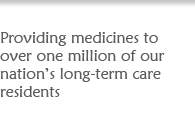Controlling Prescription Drug Spending:
Cutting Pharmacy Reimbursement is Not the Answer
What's wrong with cutting reimbursement to long-term care pharmacies?
Pharmacies do not control the prices set by drug manufacturers and wholesalers, nor do pharmacies have much control over the prescriptions written by physicians, so cutting reimbursement to pharmacies will have little impact on total prescription drug spending. It's akin to a physician treating a symptom without addressing the underlying condition.
The numbers make this very clear. Despite the fact that state Medicaid programs have not been increased pharmacy reimbursement rates in years, total Medicaid prescription drug spending has grown at an average annual rate of 18.1 percent between 1997 and 2000, over two times the annual growth rate in overall Medicaid spending.
Cutting payments to long-term care (LTC) pharmacies is especially short-sighted and will force LTC pharmacies to cut special services that they provide to the vulnerable patients they serve.
Aren't state governments overpaying long-term care pharmacies?
The report issued in 2001 by the Office of Inspector General (OIG) at the U.S. Department of Health and Human Services is incomplete, and states should not rely on its findings in setting pharmacy reimbursement rates.
While the report suggests that Medicaid programs pay pharmacies more than their costs of acquiring brand-name drugs, the OIG admits that its sole area of study was ingredient costs and that it gave no consideration to other component costs "such as & the cost to provide professional services other than dispensing a prescription for instances such as therapeutic intervention, patient education, and physician consultation; and the cost of dispensing which includes costs for computers, multi-part labels, containers, technical staff, transaction fees, Medicaid-specific administrative costs, and general overhead."
The OIG also made no attempt to study the adequacy -- or, more accurately, the inadequacy -- of Medicaid dispensing fees as reimbursement for the costs of pharmacy services.
Aren't long-term care pharmacies reimbursed for the services they provide?
Right now, most of the reimbursement for the dispensing, delivery, and other special services provided by LTC pharmacies is implicit - that is to say, LTC pharmacies find their "reimbursement" in the spread between the prices at which they purchase a drug and the average wholesale price (AWP) of the drug as reported by the drug's wholesaler or manufacturer.
While state Medicaid programs do pay a "dispensing fee" to pharmacies, even the most generous fee falls well short of the costs of dispensing by LTC pharmacies. The spread between the pharmacy reimbursement rate and pharmacies' acquisition costs has traditionally permitted LTC pharmacists to make a small profit, despite the inadequacy of state dispensing fees.
As a result, states cannot cut their pharmacy reimbursement rates, and cut dispensing fees or hold them at their current levels, and expect that LTC pharmacies will be able to continuing providing their special services to nursing home patients and other patients with special needs.
What's the solution?
Cutting reimbursement to LTC pharmacies for drugs is not the answer. The professional services that LTC pharmacies provide to the nation's frail elderly ensure that their health care is both of high quality and cost-effective, and government health plans should reimburse pharmacies -- one way or another -- for these valuable services.
If states shouldn't cut pharmacy reimbursement, what can they do to control prescription drug spending?
States have a number of options beyond simply cutting pharmacy reimbursement rates, and a number of states have employed these options successfully. Many of these options are not appropriate for the frail elderly, however, so states should strongly consider applying these policies only to relatively healthy and ambulatory seniors.
States are permitted to adopt formularies - lists of covered drugs - and exclude from these lists any drugs that do not have significant therapeutic advantages over other drugs covered under the formulary for a particular disease or condition. Physicians may still prescribe drugs which are not on the formularies, but they must first seek prior authorization from the Medicaid agency.
In addition, a number of states are considering preferred drug lists, which seek to save money by influencing physicians to prescribe less expensive drugs that provide similar therapeutic results. Drugs not listed require prior approval from a pharmacist working for the state. Florida estimates that the first year's savings from the preferred drug list will be at least $100 million, in part from supplemental rebates paid by manufacturers that wish to ensure spots on the list for their drugs.
Generic substitution policies, which require pharmacies to dispense a generic drug instead of a prescribed brand-name drug when a generic equivalent is available, are in place in at least 16 states. States without these policies have the flexibility under Medicaid to encourage the use of generics through differential dispensing fees, differential payment rates, and other similar means.
States also have broad flexibility to employ utilization management tools, such as prior authorization, drug utilization review systems, and "fail first" controls, which require physicians to show that alternative therapies are ineffective before prescribing newer and more costly drugs.
States have a variety of tools at their disposal for controlling prescription drug spending, and employing these tools makes much more sense that cutting reimbursement rates to pharmacies that neither set drug prices nor write drug prescriptions.
|


